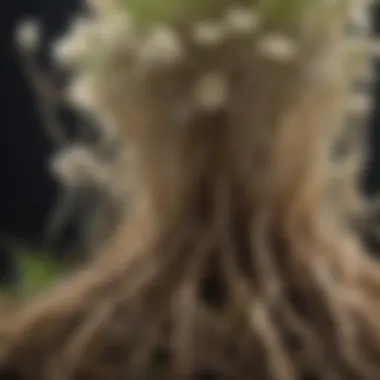Exploring the Rich Diversity of Anemone Varieties


Intro
This exploration of anemones illuminates the captivating diversity of these flowering plants. Anemones are considered remarkable in both beauty and ecological function. They span various habitats and climates, showcasing unique traits. Understanding the characteristics, habitats, and care requirements of anemones is vital for anyone interested in gardening or ecology. Knowledge in these areas can enhance cultivation efforts and contribute to a richer appreciation for their role in ecosystems.
Animal Profile
General Overview
Anemones, belonging to the family Ranunculaceae, are perennial plants found in temperate regions. They exhibit a variety of forms, from creeping ground covers to robust upright varieties. Their blooms often appear in spring and can last into late summer, showcasing colors like white, pink, red, and blue.
Habitat and Distribution
Anemones thrive in diverse environments. They prefer well-drained soil and can be found in woodlands, meadows, and coastal areas. Species such as the Japanese anemone are especially popular in gardens, while others, like the anemone blanda, often grow in rich, deciduous forests.
Fascinating Facts
Unique Traits and Adaptations
Anemones possess various adaptations that contribute to their survival. Their leaves can adjust to capture sunlight efficiently, and some species exhibit drought resistance. Many anemones have a fascinating way of reproducing, often forming tubers or rhizomes that help them survive unfavorable conditions.
Historical and Cultural Significance
Anemones have been revered in various cultures. In Greek mythology, they symbolize protection and anticipation. Various species have appeared in art and literature, representing themes of fragility and beauty.
Conservation Status
Current Population Trends
The conservation status of anemones varies by species. Some are abundant and considered stable, while others face habitat loss and population declines. It is essential to monitor their populations, particularly those in natural reserves.
Threats and Challenges
Various threats to anemone populations exist, including urbanization and pollution. Invasive species can also disrupt their natural habitats. Conservation efforts are necessary to maintain biodiversity.
Care Tips for Growers
Basic Needs and Requirements
Proper care is essential for anemones to thrive in garden settings. They require well-draining soil and moderate watering. A location with partial shade mimics their natural environments, encouraging robust growth.
Health and Wellness Tips
To ensure healthy plants, it is advisable to observe them often. Remove dead foliage to prevent disease and pests. Seasonal fertilization with a balanced nutrient mix can also promote better blooms.
Remember: Understanding the needs of anemones not only enhances your gardening success but also supports their ecological significance.
Assessing the diverse varieties of anemones offers great insights into their vital role within ecosystems. From their unique traits to their cultivation, every aspect contributes towards a better understanding of these plants and their importance.
Intro to Anemones
Anemones, belonging to the family Ranunculaceae, are remarkable plants that flourish in various environments. Their beauty, with vibrant blooms, attracts attention in gardens as well as in the wild. Understanding anemones is key for horticulturists, ecologists, and anyone interested in plant diversity. This section will shed light on the significance of anemones within ecosystems and their relevance in cultivation practices.
Definition and Overview
Anemones are perennial flowering plants, recognized for their stunning flowers that can vary in color from white to deep purple. These plants can be found in numerous habitats, from wetlands to woodlands. Anemones can be classified into two primary groups: the tuberous anemones and the rhizomatous anemones. Tubers are swollen underground stems while rhizomes are horizontal stems that grow beneath the soil surface.
Anemones are not only valued for their ornamental qualities but also play a critical role in their ecosystems. They provide essential habitat and food for various insects, particularly pollinators. Their seasonal blooms support local biodiversity, making them significant beyond mere aesthetics. Taking care of anemones and understanding their requirements can enhance gardening success and promote healthier ecosystems.


The Ecological Role of Anemones
Anemones serve crucial ecological functions in their habitats. They contribute to soil stability, prevent erosion, and promote nutrient cycling. The flowers become a haven for bees, butterflies, and other pollinators. This interaction between anemones and insects is vital for plant reproduction. Successful pollination leads to seed formation, which is necessary for the propagation of different anemone species.
Anemones not only beautify our surroundings but also sustain local wildlife.
Additionally, anemones can signal environmental health. The presence of healthy anemone populations often indicates a thriving ecosystem, showcasing a balance of flora and fauna. By cultivating these plants, individuals can foster biodiversity in their gardens. Hence, understanding the ecological role of anemones is key for both environmental conservation and gardening practices.
Exploring this topic further allows a richer appreciation of the interconnectedness between plant species and their environments. As we move forward in the article, we will delve into the classification, popular varieties, and specific care requirements of anemones.
Classification of Anemones
The classification of anemones is crucial for understanding their diverse forms and ecological roles. Knowing how anemones are categorized helps gardeners and botanists recognize the varieties that thrive in their specific environments. This classification sheds light on their biological relationships and guides proper care practices. It also enables effective conservation of delicate species that may be threatened in the wild.
Taxonomy
Anemones belong to the family Ranunculaceae, which includes a variety of flowering plants. The genus Anemone contains multiple species, which are divided further into subgenera based on their unique traits. Some common characteristics that assist in taxonomy include flower structure, leaf arrangement, and habitat preference. For example, some species are native to cold or mountainous regions, while others thrive in warmer climates. In-depth understanding of their taxonomy can aid in identifying plants and selecting suitable gardening practices.
Key Taxonomic Groups
- Anemone Patens: Known for its early spring blooms.
- Anemone Hupehensis: Prefers shaded areas and has late summer flowers.
- Anemone Coronaria: Typically found in Mediterranean climates and appreciated for its vibrant colors.
These classifications are essential for both amateur and professional horticulturists to make informed decisions when planting and maintaining anemone species.
Key Characteristics
The key characteristics of anemones are what make them desirable to gardeners and ecologists alike. First, the variety of flower types, colors, and sizes can add significant value to a garden. They can range from delicate, small blooms to larger, more showy flowers. This diversity allows for creativity in garden design.
Second, their growing habits vary widely. Some species prefer sunny environments, while others thrive in shadier conditions. Understanding these preferences is vital for successful cultivation.
- Growth Habit: Some anemones are herbaceous perennials, while others are more woody.
- Foliage: Leaf shape and size differ across species, influencing their overall aesthetic appeal.
- Fruit and Seed Formation: Anemones produce seeds that may disperse in wind or water, contributing to their spread in native habitats.
The characteristics of anemones not only enhance gardens but also influence their interactions with the surrounding ecosystem. For instance, certain species can attract specific pollinators, playing a role in local biodiversity.
Understanding the classification and key characteristics of anemones provides insights into how to cultivate and appreciate these unique plants in various settings.
Popular Anemone Varieties
The topic of popular anemone varieties is crucial to understanding the breadth of options available for cultivation and appreciation. Each variety brings unique characteristics that can enhance gardens, landscapes, and ecological systems. Knowing these varieties allows gardeners and plant enthusiasts to select the ideal species suited for their environment and personal aesthetic.
Anemone Coronaria
Habitat
The native habitat of Anemone Coronaria includes the Mediterranean region. It thrives in areas with well-drained soil and full sun exposure. This variety is often found in dry, rocky places, making it a resilient choice for similar garden conditions. It does not do well in overly wet environments, which can lead to root rot.
Cultivation Tips
When cultivating Anemone Coronaria, it is essential to ensure good drainage in the soil. The addition of sand or grit can improve drainage. They prefer a sunny location for optimal growth. Watering should be moderate; overwatering can be detrimental. This anemone also benefits from a light winter mulch to protect its roots from severe cold.
Anemone Patens
Habitat
This species is naturally found in open fields and grasslands across North America. It grows best in light, sandy soils that drain well. Anemone Patens prefers slightly acidic to neutral pH levels, making it a good candidate for a range of environments when proper conditions are replicated.
Cultivation Tips


For successful growth of Anemone Patens, it’s advisable to plant them in well-draining sandy soil. They require a spot that receives full sun to partial shade. Mulching can help retain moisture in the soil while still allowing drainage. Regular deadheading will encourage continuous blooming, enhancing garden aesthetics throughout spring.
Anemone Hupehensis
Habitat
This species is native to East Asia and thrives in woodland margins or shaded environments. It prefers loamy soil rich in organic matter, which supports its growth. Its preference for humidity means that it will do well in areas where moisture is regularly present.
Cultivation Tips
To cultivate Anemone Hupehensis effectively, ensure they have ample moisture, especially in the growing season. Regular watering and mulching can help maintain soil conditions. Placing them in partial shade can enhance their growth and flower production, especially in hotter climates. They will appreciate some protection from strong winds to avoid damage to their flowers.
Anemone Sylvestris
Habitat
The snowdrop anemone is found naturally in the grasslands and woodlands of Europe. It favors well-drained soil, particularly in temperate regions. It can adapt to a variety of soil types, which adds to its versatility in cultivation.
Cultivation Tips
For a successful planting of Anemone Sylvestris, choose a location with good drainage and partial shade. They are relatively low-maintenance once established. Regular watering is essential during dry periods, especially in their early growth. They also appreciate seasonal mulch to enhance soil moisture retention.
Anemone Rivularis
Habitat
This species thrives best in the dappled light of woodland settings, often near streams or damp areas. It prefers rich, moist soil that can retain some moisture while still allowing for drainage. Its natural habitat makes it suitable for shade gardens, where it can flourish.
Cultivation Tips
To grow Anemone Rivularis, ensure the soil stays consistently moist but not waterlogged. Shade to partial shade is preferred for optimal growth. Regular fertilization can support its blooming phase, leading to vibrant displays. However, excess sunlight can lead to wilting, so placement should be considered carefully for long-term success.
Growing Anemones in Different Environments
Understanding the diverse environments where anemones can thrive is essential for any gardener or plant enthusiast. Different settings will influence not only the growth but the aesthetic and health of these plants. By exploring garden cultivation, container gardening, and wild anemone habitats, we aim to provide a comprehensive guide on how to successfully grow anemones.
Garden Cultivation
Soil Requirements
Soil quality is a critical aspect when growing anemones. They prefer well-drained, loamy soil rich in organic matter. A sandy or clay-rich soil can lead to water retention, which is detrimental to their roots. Good drainage prevents root rot and is essential for their overall health. This soil condition is a popular choice, as it mimics the natural habitats where anemones flourish. Without careful soil management, the plants may suffer from poor growth and flowering.
Sunlight Needs
Anemones generally thrive in full to partial sunlight. Most varieties require at least six hours of sunlight each day. This sunlight enables photosynthesis and contributes to robust growth. However, in extremely hot climates, some shade during the hottest part of the day helps preserve moisture and prevents stress on the plants. Knowing the specific sunlight needs is crucial for ensuring optimal blooming and plant vitality.
Watering Guidelines
Watering is another vital component in the cultivation of anemones. They require consistent moisture, especially during the growing season. The key is to keep the soil moist but not soggy. Overwatering can lead to root problems, while underwatering can stunt growth. A balanced watering schedule supports robust development and flowering. Monitoring the moisture level can be advantageous, as it helps in avoiding common mistakes that harm the plants.
Container Gardening
Choosing the Right Container
Selecting an appropriate container is crucial for growing anemones in limited spaces. Containers should have sufficient drainage holes and be large enough to allow for root expansion. A pot made from breathable materials like clay can help regulate temperature and moisture. Using the right container facilitates healthy growth and manages potential water issues. Gardening with containers provides the flexibility to relocate plants as conditions change.
Mixing Soil


Mixing soil for container gardening affects the health of anemones significantly. A combination of potting soil, organic compost, and perlite or sand improves drainage and nutrient availability. This blend enhances root development and overall plant strength. Proper mixing ensures that the anemones have space to grow and sufficient nutrients to flourish. However, it requires attention to maintain the correct proportions for the best results.
Mobility and Storage
Mobility is one of the advantages of container gardening. Pots can be moved to take advantage of changing light conditions or to protect the plants from extreme weather. Storage becomes significant during harsh seasons. This flexibility allows gardeners to keep their anemones safe and healthy year-round. However, frequent movement can disturb the plants if done carelessly, causing stress or damage.
Wild Anemone Habitats
Natural Distribution
Anemones have a wide natural distribution, adapting to various climates and soil types. They can be found in meadows, woodlands, and coastal areas. This distribution emphasizes their resilience and versatility. Understanding their natural habitat allows gardeners to replicate those conditions in cultivation. However, wild populations face challenges from habitat destruction, making conservation awareness important.
Interaction with Local Flora
The interaction with local flora is vital for understanding anemones. They often coexist with grasses, ferns, and other perennial plants. This community can enhance biodiversity and contribute to the health of the ecosystem. In wild settings, anemones provide shelter and food for various insects. However, competition for resources can also challenge their growth. Observing these interactions helps gardeners appreciate the ecological roles anemones play.
The adaptability of anemones highlights their importance both in ecosystem dynamics and as cultivated plants in gardens. Understanding how to manage growing conditions is essential.
In summary, cultivating anemones requires careful consideration of their growing environments—whether in gardens, containers, or their wild habitats. This knowledge informs better gardening practices and enhances appreciation for these fascinating plants.
Anemones in Art and Culture
Anemones have long captured the fascination of artists and cultures across the globe. Their vibrant colors and distinctive shapes make them a popular subject in artistic expressions including painting, literature, and poetry. The significance of anemones in various art forms illustrates not just their aesthetic appeal but also the deeper meanings associated with them. Understanding this cultural relevance enhances our appreciation of these flowers beyond their natural beauty, allowing us to see how they serve as symbols and motifs in human expression.
Symbolism of Anemones
Anemones often symbolize different concepts depending on cultural context. In many Western traditions, they represent protection against evil, making them a popular choice in floral arrangements for significant events. In the language of flowers, anemones convey messages of abandonment and fading hope, encapsulating emotions of loss and longing.
In Japanese culture, anemones hold a different meaning. They symbolize love and intimacy, often used to express tender feelings among loved ones. This contrast between cultures reflects the versatility of the anemone as a symbol and highlights its importance in conveying complex human sentiments.
Some interpretations regard anemones as a reminder of the fragility of life, a theme prominently featured in various artworks. This duality of meaning enriches their presence in artistic narratives and deepens the viewer's engagement with the depicted themes.
Cultural References
Anemones appear in various literary works and artistic representations across history. For instance, they feature in the Impressionist paintings of Claude Monet, who captured their delicate beauty in his work. This artistic choice highlights their visual impact and emotional resonance.
In literature, anemones have been referenced in poetry, emphasizing themes of transience and emotional states. Writers often utilize anemones to evoke feelings of nostalgia or melancholy.
Additionally, folklore from different cultures contains references to these flowers, presenting them in stories that weave in themes of love, loss, and nature's cycles. The anemone thus serves as a rich source for artistic inspiration, bridging nature and human emotion.
“Anemones are not just flowers; they are a language of emotion, woven into the fabric of art and culture.”
This intricate interplay between nature and art highlights the anemone's role as more than a simple floral variety, establishing it as a significant cultural element around the world.
Ending
The conclusion of this article serves as a vital summation of the extensive knowledge provided about anemones. Understanding the various anemone varieties is not just an academic exercise but a gateway to appreciating their beauty and ecological roles. Anemones are not merely ornamental plants; they contribute significantly to their ecosystems. Acknowledging this importance can enrich gardening practices and foster a greater appreciation for biodiversity.
Summary of Key Points
In summary, we have explored several crucial elements regarding anemones in this article:
- Diversity: Anemones are represented by a wide range of species, each with unique characteristics and habitats.
- Ecological Significance: They play important roles within their ecosystems, supporting local flora and fauna.
- Cultivation: Specific tips for growing anemones in gardens and containers have been provided, highlighting their care needs.
- Cultural Relevance: Anemones hold various meanings across cultures, adding depth to their significance beyond gardening.
Understanding these points allows gardeners, educators, and biologists to engage more deeply with anemones, enhancing their appreciation and cultivation practices.
Final Thoughts on Anemone Varieties
Reflecting on the diversity of anemone varieties encourages a multifaceted understanding. Each species displays unique adaptations and requirements, prompting careful consideration for optimal care. Moreover, appreciating the ecological roles anemones play can inspire conservation efforts.
As you delve into growing anemones, consider not only their beauty but also their importance in the ecosystem. By cultivating these exquisite plants, you contribute to the preservation of biodiversity. Embrace the opportunity to explore and learn more about anemones, enriching your gardening knowledge and practices in the process.
By understanding the intricacies of anemone varieties, gardeners and enthusiasts can play a proactive role in fostering ecological balance and appreciating nature's diversity.















